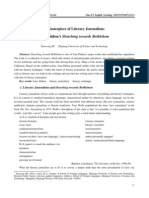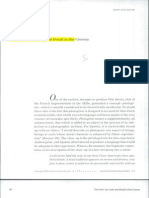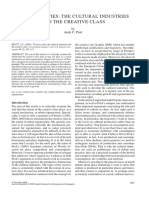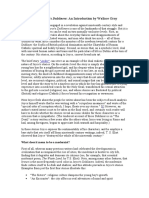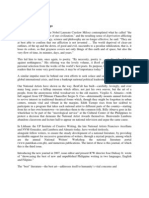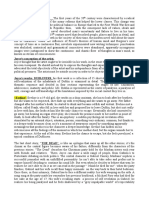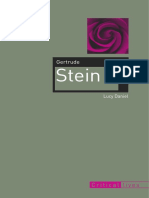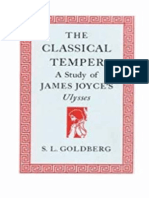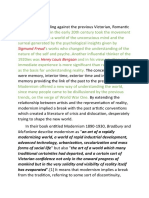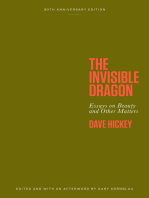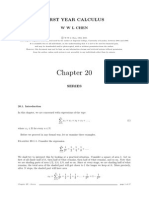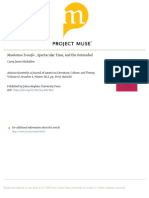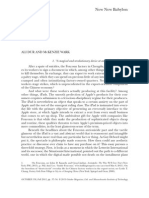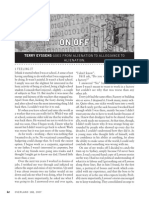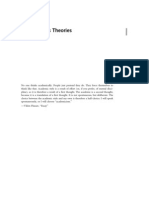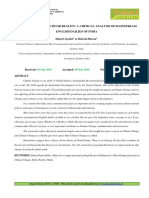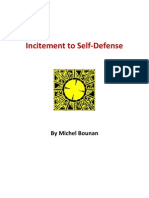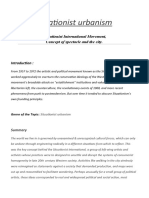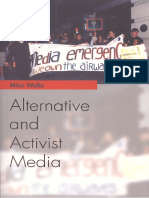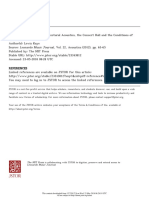Reading Five Bells
Reading Five Bells
Uploaded by
nigerianhacksCopyright:
Available Formats
Reading Five Bells
Reading Five Bells
Uploaded by
nigerianhacksCopyright
Available Formats
Share this document
Did you find this document useful?
Is this content inappropriate?
Copyright:
Available Formats
Reading Five Bells
Reading Five Bells
Uploaded by
nigerianhacksCopyright:
Available Formats
Invitation to the Voyage: Reading Gail Joness Five Bells
ROBERT DIXON
University of Sydney
Gail Joness novels cannot be understood fully without making connections between them and the essays she publishes as an academic. Like a number of theoretically-informed contemporary writersBrian Castro is anotherher body of work demands to be read as a whole: that is to say, her novels are often ways of thinking through in fictional form the theoretical issues that preoccupy her in her essays. Joness earlier novels often deal with Australians who travel or live abroad and engage with aspects of modern global culture. Five Bells (2011), the first since her move to Sydney in 2008, is set entirely at Circular Quay, yet its characters seem designed to illustrate the cosmopolitan, multi-cultural nature of contemporary Australian society. As Stella Clarke wrote in an early review, Five Bells is both explicitly Australian and insistently cosmopolitan; Joness Sydney is a global hub and her literary allegiance exceeds national boundaries (18). There are four main characters. Ellie is a postgraduate student from Western Australia who has come to Sydney to do a PhD in literary studies. James DeMello, Ellies childhood friend, has come in search of her: originally a medical student, he retrained as a primary school teacher but has since been traumatised by the death by drowning of a young student in his care. Catherine Healy is an Irish woman who has come to Sydney as a tourist after the death of her brother Brendan in a motorcar accident. Pei Xing is an elderly Chinese woman who has immigrated to Sydney from Shanghai where, during the 1960s, she and her family experienced the horrors of the Cultural Revolution. The fifth character alluded to in the title is a little girl whom we glimpse in the opening pages of the novel, and who reappears at the end when she is reported on the evening news as a missing person. Ellie, Catherine and Pei Xing are potential witnesses to her disappearance. In this article I will outline several contexts that I believe will be foundational for subsequent readings of the novel. They include its relationship to Kenneth Slessors poem of the same name; Joness interest in the French Situationist International and their theories of urbanism and psychogeography; the influence of Virginia Woolfs Mrs Dalloway (1925), trauma studies and the trauma novel; and another cluster of themes associated with Boris Pasternaks Doctor Zhivago (1957), World Literature, cosmopolitanism and global translatio. Kenneth Slessors Five Bells In an interview with Catherine Keenan for the Sydney Morning Herald in 2011, Jones indicated some of the conceptual frames that inspired her in this novel. The first is Kenneth Slessors poem, Five Bells as Keenan explains: The title of her novel is, of course, a nod to Kenneth Slessors famous poem. Jones was coming home on the ferry one night, after dinner at a friends house, when the dark wash of water made her think of Five Bells. One of the things that interested her was that the poems sadness, its elegiac quality, was so strong, even though it was written many years after Joe Lynchs death, the event it mourns. Her book doesnt draw on the poem or its subject directly; she thinks of it more as a trigger for a meditation on the idea of time as water. (31)
JASAL 12.3
DIXON: Reading Gail Joness Five Bells
Written in 1937 and first published in 1939, Five Bells is an elegy on the death of Slessors friend, Joe Lynch, an artist and noted bohemian, who drowned when he fell from a ferry at Circular Quay on the night of Saturday 14 May 1927 (Kirkpatrick 263-72). Kate Lilley suggests that the poem is characterised by a thematics of death, in which the relationship between the elegist and elegised (mourner and mourned) becomes radically interchangeable (290, 246). Ironically, the harder the poet works to resurrect the presence of the deceased, the more his own memories of Joe seem to disintegrate. As Kevin Hart puts it, Joe is gradually realised as an absence (194-5). Poetry cannot recapture the essence of the dead, who nonetheless haunt the memory of the living: I felt the wet push its black thumb-balls in, The night you died, I felt your eardrums crack, And the short agony, the longer dream, The Nothing that was neither long nor short; But I was bound, and could not go that way, But I was blind, and could not feel your hand. (124) Like the poet in Slessors elegy, Joness characters carry into the present their memories of the dead and of their own past lives. This is what Hart means when he suggests that Five Bells registers the weight of the dead and meditates on the ambiguities of their possible return (190-1). Pei Xing carries not only the memories of her dead parents and her dead husband within her but has lived such a complex life that she also carries many versions of her past self: Pei Xing felt the tremor of the ferry Then she saw herself from the inside: those layers of self slowly, gently, time-travelling across the water In the wilderness of leaving Shanghai, these selves had blended and folded; now, in meditation, she was able to fan them apart. I have lived many lives. (13) Catherine Healy is on holiday in Sydney, but her dead brother Brendan haunts her memories: Most of all she thought of Brendan, though he was no longer in the world, and it was a riddle to her how powerfully the dead continued, how much space they took up with their not-here bodies. Brendan lay trapped in her atoms and in the folds of her brain, he had infiltrated, somehow (53) For James DeMello, Ellie is like a passenger he carries in his mind: He must tell Ellie how he had carried her, all these years, how through everything there persisted the residue of her affinity and understanding. She was a voice in his head; she was a passenger he transported. (105) And then there is the moment of Jamess suicide, which explicitly recalls the language and imagery of Slessors poem: James slipped over the edge and the whisky pulled him down. At first it was a bounteous wash of dark and light The Harbour seemed to throb around him as the ferry pulled away, and then slacken and gently take him and require his
JASAL 12.3
DIXON: Reading Gail Joness Five Bells
surrender. There were verticals of filmy light and fish-shapes breaking open. He felt the water of the Harbour enter his body. His chest was filling. The black wet pushed its thumb-balls in. (208) Joness novel therefore pays homage to Slessors poem, and they share a number of themes: the impact of Sydney, especially Sydney Harbour as a place; its historic role as a point of arrival and departure for people whose lives are in movement around the world; and some of core themes about social modernity, including the experience of urban life, the tidal effects of memory and mourning in relation to chronological time, and the central role of trauma in modernity, and in modern literature. The Situtationist International, urbanism and psychogeography I want to turn now to the second of those frames that Jones signalled in her interview with Keenan, and will begin with Keenans account of the importance to Joness work of French theorist Guy Debord and the Situationist International: [Psychogeography] informs this book and comes out of the 1960s, specifically the work of Guy Debord and the Situationists. Cities are conventionally associated with consumerism and oppression and the controlled movement of bodies. [Jones] is drawn to Debord because he proposed a different model of the city as a kind of aesthetic object. Our life in cities isnt just this apprehension of spectacles and the moment of consumption, she says. Its intersected by a lot of aesthetic moments. The ingress and egress from a building, walking into George Street and seeing Sydney Harbour Bridge at the endthat ought to be an experience of radical attention to the look of things and the aesthetic moment. Im really interested in what [the Situationists] say about space and bodies and the reinvention of aesthetic apprehension for a kind of liberating, emancipatory end. (Keenan 30) The Situationist International was a group of revolutionary artists and theorists based in Paris which was founded in 1957 and reached the peak of its influence with the General Strike in May 1968. Its central figures were Debord, his partner, the writer Michelle Bernstein, the Danish artist Asger Jorn, and Russian theorist Ivan Chtcheglov. With their intellectual roots in Marxism and the avant-garde art movements of Dada and Surrealism, the Situationists were engaged in a critique of capitalism and its expression in commodity culture, advertising, modern architecture and modern city planning. Debord called this the Society of the Spectacle. By this term, he meant not just individual images or events or objects in consumer society but their sum total as an overwhelming, all-encompassing environment that controls everyday life. He argued that modern consumerism creates what is essentially a fake reality that masks capitalisms degradation of authentic human life. The material form of that fake reality is the built environment of the modern city, which he describes as the materialisation of [capitalist] ideology (The Society of the Spectacle, 150). In one sense, then, the Situationists project was a negative critique of modern consumer society. But there was another, more positive impulse that sought to formulate strategies that individuals could use to combat the society of the spectacle, learning how to inhabit the city in ways that are subversive, authentic and life-affirming. Of these two impulses, it is the second, utopian one which I think Jones is most inspired by in Five Bells: that is to say, she is inspired by the Situationists attempt to re-occupy the modern city by subverting its
JASAL 12.3
DIXON: Reading Gail Joness Five Bells
alienating effects as a site of consumption and work. In this respect, the Situationsts were heirs to the flneurs of the fin-de-sicle and the bohemians of the 1920s, whom Slessor evokes in his elegy for Joe Lynch. What Slessor remembers most vividly is wandering through the cities of Sydney and Melbourne at night with his bohemian friend. This is what the Situationists called drifting. One of the Situationists key strategies for re-taking urban space was the theory of the drive, or drift. In his 1958 essay, Theory of the Drive, Debord recommends that instead of moving through the modern city according to its rules, the resistant individual should drift through it, surrendering themself to the often wayward impulses generated by personal memories, chance encounters, momentary architectural attractions, or residual clues to the pre-history of the city embedded in its contemporary built environment. By using their own desires, memories and imagination as a resource, the urban drifter can aestheticise the otherwise banal and affectless urban landscape. The inner responses experienced during a drive were to be the subject of a new science, psychogeography, a study of the affective comportment of individuals engaged in urban drift. To illustrate his theories, Debord made psychogeographic maps of Paris in which wandering arrows guide the drifter through the city against the grain, directing them to places where chance encounters or associations might lead to the aesthetic moments he called situations.
Guy Debord, Guide to Psychogeography of Paris, collage, 1957.
In one these collages, Debord inserted at the end of the trail of arrows, as if it were the destination of the drive, a reproduction of the seventeenth-century French painter Claude Lorrains Seaport with the Embarkation of Saint Ursula (1641).
JASAL 12.3
DIXON: Reading Gail Joness Five Bells
Claude, Seaport with the Embarkation of Saint Ursula The National Gallery, London
Debord and Chtcheglov were fascinated by Claudes landscapes, which they saw as an incitement to drifting. They are fantasy spaces filled with possibilities for play and openness, in which palaces open directly on to the wharves, where a ship awaits the traveller, a symbol of perpetual invitation to the voyage (McDonough 8-9). The Situationists opposed Claudes imaginary landscapes to the new regulated town planning of Le Corbusier, the leading modernist architect and advocate of anti-urbanism. In Formulary for a New Urbanism (1953), Chtcheglov writes, A Le Corbusier model is the only image that arouses in me the idea of immediate suicide. He is destroying the last remnants of joy. And of love, passion, freedom. By contrast: Many of [Claudes] admirers are not quite sure to what to attribute the charm of his canvases. They talk about his portrayal of light. It does indeed have a rather mysterious quality, but that does not suffice to explain these paintings ambience of perpetual invitation to voyage. This ambience is provoked by an unaccustomed architectural space. The palaces are situated right on the edge of the sea, and they have pointless hanging gardens whose vegetation appears in the most unexpected places. The incitement to drifting is provoked by the palace doors proximity to the ships. The similarities between the cover of the first Australian edition of Five Bells and Claudes Seaport with the Embarkation of St Ursula are strikingly suggestive: the dreamy light, the fantastic buildings, the site of embarkation.
JASAL 12.3
DIXON: Reading Gail Joness Five Bells
Gail Jones, Five Bells (Sydney: Vintage, 2011), cover.
Like the Situationists, Joness characters are engaged in urban drifting. They take up the invitation to disobey the citys rules, and to develop alternative strategies: the discovery of chance encounters with others, the memory of some image or line from a painting or poem that triggers associations, the unpredictable effect of ambiguous architectural spaces. They discover aesthetic situations and surrender to the tidal undercurrents of history and memory concealed beneath the banal surface of modern capitalism. Each of Joness characters might be thought of as inscribing one of Debords psychogeographic route maps as they allow their memories and passions or chance encounters to affect their passage through Sydney. In the opening pages, each is drawn across the city toward Circular Quay, though following different routes through the citys transport system and its architectural spaces: The train swung in a wide arc to emerge alongside sturdy buildings and there it was, the first glimpses through struts of iron-work, and those blurred partial visions were a quiet pleasure. Down the escalator, rumbling with its heavy bodycargo, through the electronic turnstile, which captured her bent ticket, then, caught in the crowd, she was carried outside. With a trampoline heart she saw the Bridge to her left: its modern shape, its optimistic uparching. (1) This is Ellie arriving at Circular Quay. It is one of the examples of urban drifting that Jones described in her interview: walking into George Street and seeing Sydney Harbour Bridge at the endthat ought to be an experience of radical attention to the look of things and the aesthetic moment. Although Ellie is drawn along by the transport system and the architecture, this is not a totally controlling environment, and as each of the characters arrives, we begin to see that they have their own peculiarities, responding to chance encounters and even to the same sights in utterly unique ways. For Ellie, the first sight of the Opera House fills her with joy (3); for James it reminds him of sharks teeth, triggering childhood memories of trauma and foreshadowing his death by drowning (5-6); for Pei Xing it is like a set of porcelain bowls (12), suggesting her Chinese heritage and her pleasure in domestic ceremonies (12); for Catherine it is like blown roses (4). These different images might be compared to the Vivid Light Festival that has been held in Sydney in recent years, itself a psychogeographical event. During the festival, familiar buildings like the Opera House and the Museum of Contemporary Art, and locations throughout the Rocks and Macquarie Street,
JASAL 12.3
DIXON: Reading Gail Joness Five Bells
are projected with changing images, transforming them into something other than what they seem, and people are encouraged to wander through the city at night discovering these potentially emancipating effects. As she moves around Circular Quay, Pei Xing is given to disobeying the rules: she pauses to chat with a Greek man selling gelato and he refuses to accept payment from her (9). This is a subtle way of refusing the demands of consumer society and re-creating authentic human contact. Pei Xings route through the city is very different to that of James DeMello, who is staying in downtown George Street. Here we sense the Situationsts critique of the city as a site of alienation. In a reversal of Pei Xings encounter with the ice cream seller, James watches prostitutes working the streets at night, people who are literally turned into commodities (29). Sydneys Circular Quay is therefore an ideal spatial field for a drive, giving out a perpetual invitation to the voyage. Historically it is the point from which Australians set off for overseas and where new Australians arrive, and several of Joness characters literally embark on ferry rides from these wharves. One of them, which ends in Jamess suicide, confirms the Situationists pessimism about the modern city. But two other voyages to the north shore, by Catherine and Pei Xing, are psychogeographic, suggesting the utopian and life-affirming aspects of the Situationists project. Catherines voyage to Cremorne Point is a spur of the moment choice that allows her to re-enact in her memory the journey her family made to Loreto in Italy on a religious pilgrimage after her brothers death: Catherine stepped into the sunshine. She would take a ferry ride, she decided, for no reason other than to cross the Harbour and come back again in such splendid weather. And she was thinking once more of Brendan, and how he would have loved this, the light, the unruly adventure of Sydney. (162) Catherines ferry-ride to Cremorne, on which she remembers her trip to Loreto in Italy, takes her past Loreto Kirribilli. Although Catherine is not herself religious, like her mother, her urban drifting in Sydney is a kind of secular pilgrimage, a journey of healing. Virginia Woolfs Mrs Dalloway (1925), trauma studies and the trauma novel I come now to the third context suggested in Joness interview with Keenan: Novels about a single day are another thing Jones is interested in, from Joyces Ulysses [1922] through to her favourite, Virginia Woolfs Mrs Dalloway [1925]. She has recently been re-reading Woolfs diaries and was fascinated by the architectural metaphors Woolf uses, about excavating the spaces behind the present. Joness novel has similar concerns: the characters pasts balloon out as they take their familiar walk around the ferries and souvenir shops. (Keenan 301) There are many structural and thematic parallels between Mrs Dalloway and Five Bells, just as there are between Joness novel and Slessors poem. Both novels take place over a single summers day; both use free indirect discourse to bring into proximity the inner life worlds of a small cast of characters. What I want to focus on, though, is not just this technique, which Jones takes from Woolf, but its association with traumatic memory. As Karen DeMeester argues, the modernist literary works written in the decade after World War I constitute a literature of trauma and their experimental forms often replicate the damaged psyche of a trauma survivor (650). In both novels a number of characters suffer from the effects of
JASAL 12.3
DIXON: Reading Gail Joness Five Bells
traumatic memory: Woolfs Septimus Smith, for example, corresponds roughly with James DeMello: a veteran of the Great War, he suffers from shellshock and at the end of the day commits suicide by jumping from a hospital window. Joness characters, however, display an interesting range of traumatic symptoms, most obviously the marked difference between James, who, like Smith, is unable to communicate his trauma and return to health, and Pei Xing, who realises when she meets her former prison guard in Sydney that she must communicate with her and work through a process of forgiveness and healing. As DeMeester puts it, Communication [of trauma] is health; communication is happiness (141). These differences in the way Joness characters deal with the experience of trauma roughly correspond to the different strategies of the Situationists in responding to urban space: that is to say, the pessimistic, negative critique of anti-urbanism, which Chtcheglov describes as suicide-inducing, or the positive and utopian strategies of the new urbanism, which are joyful and life-affirming. Just as James is caught in the repetitive return of his trauma, so he is at the mercy of the inner city, the all-controlling society of the spectacle. Ellie, by contrast, seems immune to traumatic affect. Pei Xing has suffered more deeply than James but is more resilient and better able to communicate, to work through trauma, just as she and Ellie are better at urban drifting. As they move through the city, which James finds depressing, Pei Xing and Ellie aestheticise the urban space around them, respond positively, even joyfully to chance encounters with other people, and display resilience in the face of trauma. Trauma studies, the trauma novel and trauma aesthetic For the last 30 years or so, a number of critics have remarked that Western societies have become obsessed with issues of memory, trauma and memorialisation. Initially this began as a concern in medical and psychiatric discourse but it has now spread to research in the humanities in general. The term Post Traumatic Stress Disorder, with which we are now so familiar, was first used in 1980 by the American Psychiatric Association to describe the symptoms experienced by survivors of the nuclear blast at Hiroshima, and by veterans of the Korean and Vietnam Wars. This is a paradoxical condition that involves, on the one hand, flashbacks, recurring dreams and memories of a traumatic event and, on the other hand, avoidance, blockage or an emotional numbing to the total recall of the originary event (Luckhurst 1). Although research on PTSD began with work on Vietnam Veterans, in the 1980s and 1990s in the United States it was the Holocaust that came to stand as the master signifier of cultural trauma. Interest in Holocaust testimonies increased considerably with the release of Claude Lanzmanns 1993 film Shoah, and the unveiling in the same year of a national monument to the Holocaust in Washington D.C., the Holocaust Memorial Museum (Luckhurst 59ff). The effects of 9/11 confirmed the importance of trauma culture in the United States, but more recently trauma has been examined in other contexts, such as the Pol Pot regime in Cambodia, the Apartheid regime in South Africa, and the Stolen Generations in Australia. We can define trauma studies as the application of clinical definitions of trauma to the explanation of cultural processes in general: that is to say, the conditions of trauma suffered as a pathology by individuals are applied as an explanatory paradigm to the culture as a whole (Luckhurst 4). This has led scholars in literature, cultural studies and the visual arts to study the circulation of trauma through such media as personal memoirs and testimony, novels, cinema, photography and public memorialisation. Clearly, several of Joness characters in Five Bells suffer the clinical symptoms of individual trauma. A question that
JASAL 12.3
DIXON: Reading Gail Joness Five Bells
might be asked is whether the culture Jones depicts as a whole can also be said to be a culture of trauma. In other words, does Jones depict traumatised individuals or a culture of trauma? There is now a distinct literary form that has been called the trauma novel, and I want to suggest that Five Bells belongs to this type. Examples of trauma fiction began to proliferate from the late 1980s, when the term PTSD was first named, and spread rapidly to include Holocaust survival, as well as slavery, rape, and child sexual abuse. There is now a canon of international trauma novels which arguably begins with Toni Morrisons Beloved (1987), includes Margaret Atwoods Cats Eye (1988) and Pat Barkers Regeneration trilogy (19911995), and culminates in W.G. Sebalds Austerlitz (2001) (Luckhurst 87). In Australia, trauma novels have tended to focus on issues arising from colonisation, the Stolen Generations and Reconciliation. They include David Maloufs Remembering Babylon (1998), Kate Grenvilles The Secret River (2005), and Alex Millers Journey to the Stone Country (2003) and Landscape of Farewell (2007). Joness Dreams of Speaking (2006) deals with the paradigmatic trauma event of the nuclear bombing of Hiroshima, while Sorry (2007) deals with the Stolen Generations. By including Pei Xings story of the Cultural Revolution in Five Bells, Jones is therefore extending the now classic American and European cases to recognise traumatic events in Asia and, at the same time, their proximity to Australia as a European settler nation located in Asia. The grouping of such texts as trauma novels presupposes that they share certain thematic and aesthetic qualities, and Roger Luckhurst argues that there is a distinct trauma aesthetic. The trauma novel must have a narrative form that inherently disrupts time and chronological narrative. That is to say, because of its repetitive and disruptive symptoms, trauma requires a literary form that departs from conventional linear sequence. Trauma narratives, then, incorporate the rhythms, processes and uncertainties of traumatic memory within the temporal structure of the work (Luckhurst 88). It is for this reason that the stylistic innovations of modernist novels like Mrs Dalloway are regarded as foundational to the trauma aesthetic and trauma novel, especially free indirect discourse, prolepsis, and the flashback or analepsis. A number of Joness characters in Five Bells suffer from the symptoms of traumatic memory, but it is James DeMello who best fits the classic definition of trauma. Luckhurst identifies three symptoms: Individuals who experience wars, disasters, accidents or other extreme stressor events seem to produce certain identifiable somatic and psych-somatic disturbances. Aside from myriad physical symptoms, trauma disrupts memory, and therefore identity, in peculiar ways. The first cluster of symptoms relate to the ways in which the traumatic event is persistently re-experiencedthrough intrusive flashbacks, recurring dreams, or later situations that repeat or echo the original. Weirdly, the second set of symptoms suggests the complete opposite: persistent avoidance of stimuli associated with the trauma that can range from avoidance of thoughts or feelings related to the event to a general sense of emotional numbing to the total absence of recall of the significant event. A third set of symptoms points to increased arousal, including loss of tempter control, hypervigilance [and substance abuse] (1) The reader of Joness novel first encounters the symptoms of Jamess trauma before we learn their cause. The first hint is his response to the Opera House, which the other characters have
JASAL 12.3
DIXON: Reading Gail Joness Five Bells
aestheticised in ways that are pleasant and even joyful. James, by contrast, associates its famous sails with sharks teeth and death by drowning, which precipitates a series of visual memories. These images look back to the death by drowning of his student and forward to his own suicide. The novel therefore enacts the disruptive effect of traumatic memory by delaying our knowledge of the cause of Jamess trauma until later, but showing its hold over him from the beginning. At the same time, by their translation into symbolic forms, these images display the second of Luckhursts classic symptoms: the paradox that the memory both recalls the traumatic event, yet is unable to face it directly. James is a therefore a classic melancholy subject, controlled by traumatic memory that intrudes repeatedly into the present. From the outset, these memories take a strongly visual form, and again this corresponds to classic theories of trauma. In an influential account, Cathy Caruth has said that Traumatic experience is understood as a fixed and timeless photographic negative stored in an unlocatable place of the brain, but it maintains the ability to interrupt consciousness (quoted in Balaev 150). Luckhurst notes that one of the central ways in which contemporary trauma has been conceived is around the symptom of the intrusive or recurrent image, the unbidden flashback that abolishes time and re-immerses you in the visual field of the inaugurating traumatic instant (147). Slessors memories of Joe Lynch in Five Bells, as Philip Mead demonstrates, also take on distinctly photographic and even cinematographic qualities (80). In Five Bells, this classic concept of trauma as the intrusive repetition of visual images is reflected in James DeMellos interest in the visual arts, especially his obsession with the life and work of the French Surrealist painter Rene Magritte. The death by drowning of Magrittes mother, Adeline, and the covering of her face with cloth are obsessively repeated in his paintings. Jamess obsession with Magritte is both an insistent restatement of his own wounds, the mental illness of his mother and the drowning of his student, and a displacement of them into other content, so that it enacts the paradox of traumatic experience: it is both known and unknown; stated and not stated; visible in open sight yet veiled from full consciousness by symbolic displacement. Shortly after the wound of his mothers death by drowning, Magritte worked in a wallpaper factory designing repetitions: It was easy, to repeat. Any loose flourish would appear whole if chained in a repetition. Any single flower became many, and rough abstraction a pattern (31-2). The repeated patterns of wallpaper suggest the first of Luckhursts symptoms: the repeated visual recall of the traumatic memory. Yet Magrittes obsession with the shroud suggests the paradoxical second symptom: the minds inability to face the traumatic memory directly, which it veils by symbolic transformation. As a Surrealist, Magritte was fascinated by the logic of dreamwork, which protects the conscious mind by transforming threatening or disturbing images into other content whose symbolic meaning is nonetheless readable to the analyst. For this reason, Magrittes paintings are filled with figures [that are] blinded or covered in cloth (32). The example discussed at length in the novel is Magrittes painting, The Lovers (Les Amants) (1928): It was a portrait of two enshrouded heads, both swathed in grey cloth. The obliteration of detail was surely all the artist could bear. His images were of displacement and his figures were all verging on erasure. Particularity would have killed him. Realism could have killed him. (36)
10
JASAL 12.3
DIXON: Reading Gail Joness Five Bells
Rene Magritte, The Lovers (Les Amants) 1928 oil on canvas 54x73cm National Gallery of Australia, Canberra Rene Magritte/ADAGP. Licensed by Viscopy
These images both are and are not Magrittes mother, just as Jamess interest in Magritte both is and is not the symptomatic expression of his obsessive return to the loss of his own mother and the drowning of his student. Vernacular Cultures of Trauma James DeMellos traumatic symptoms and Joness presentation of them through the use of flashbacks and prolepsis are a text-book illustration of what Luckhurst calls the trauma aesthetic. I want to argue, though, not just that Five Bells reflects the concerns of trauma studies and other trauma novels, but that in certain respects it maps out future directions for this field. The first is that Joness is interested in the role played by popular culture in the transmission of trauma. As we have seen, trauma theory has long been associated with high modernist art forms like the novel, lyric poetry (including the elegy) and Surrealist painting, but trauma is also transmitted by the new media that define the era of globalization, including advertising, popular music, news media, television and the internet. In their introduction to World Memory: Personal Trajectories in Global Time, Jill Bennett and Rosanne Kennedy introduce the term vernacular cultures of trauma to refer to the many ways in which traumatic experience now circulates in everyday life (5). Jones was inspired by modernist texts dealing with traumatic memory, but Five Bells is clearly postmodern in its perspective, especially its interest in the vernacular cultures of
11
JASAL 12.3
DIXON: Reading Gail Joness Five Bells
trauma. Jones is interested, for example, in the way traumatic memory is carried in the body as well as in the visual memory: James remembers both his father and Ellie through the imprint of their bodies and touch. Popular music and visual culture are intimately connected to traumatic memory and the cultural and cross-generational transmission of trauma. Jamess painful memories are provoked, for example, by a man in a black T-shirt with a teen spirit logo, which leads him to recall a Nirvana film clip and the suicide of Kurt Cobain (74-5). For Catherine, the Irish folk song Raglan Road and the U2 song With or Without You trigger memories of her childhood and of her brother, especially through the association of Bonos voice with Brendans (92). One of the most pervasive examples of vernacular cultures of trauma is the mass media, especially news reporting on radio, in print and on television, to which Ellie displays an extreme sensitivity: There were the usual horrors. The war in Iraq, bombings in Afghanistan There was a photograph on the front page of a distraught woman in a headscarf, bending in torn, rigorous grief over the body of her son. It was generic and familiar. History would record this time as one of relentless repetition. How many images of grief might the reader of any newspaper see? (21-2) A second way that trauma studies might develop is for it to move beyond the North American and European case studies in which it originated. Bennett and Kennedy argue: trauma studies must transform from a monocultural discipline into a mode of enquiry that can inform the study of memory within a changing global context. For such an out-folding to occur, it must move beyond its focus on Euro-American events and experiences, towards a study of memory that takes as its starting point the multicultural and diasporic nature of contemporary culture. (5) A third possible direction for trauma studies in the humanities is suggested by the increasing emphasis now placed in clinical practice upon the trauma sufferers capacity for recovery. Luckhurst observes that in the wake of 9/11, when psychotherapists actually outnumbered victims, counselling often appeared to inhibit patients recovery from post-traumatic sequelae and their innate capacity for resilience. Resilience is defined as positive adaptation within the context of significant adversity (Luckhurst 210). While not meaning to diminish the very real existence of post-traumatic suffering, Luckhurst concludes that trauma theory as it appears in humanities research might follow this very different trajectory in psychiatric practice (211). In Five Bells, these three new directions in trauma studiesan interest in vernacular or everyday cultures of trauma, the out-folding to non-American and non-European cases, and the value of resilienceare personified in Pei Xing. By making an elderly Chinese survivor of the Cultural Revolution central to her Sydney novel, Jones is making a strong statement not only about the cosmopolitan nature of contemporary Australian society, but also about the American and Eurocentric nature of trauma theory and previous trauma novels. Pei Xings story is central to the books achievement because it presents an example of trauma that shifts away from its Euro-American focus, and because Pei Xing is an example of the resilient trauma subject: her pathway is one of forgiveness and working through rather than Jamess melancholic repetition.
12
JASAL 12.3
DIXON: Reading Gail Joness Five Bells
Pasternaks Doctor Zhivago (1957): World Literature, cosmopolitanism, and global translatio. I turn now to the last of my four frames for approaching Five Bells, and that is the cluster of issues around Pasternaks novel, Doctor Zhivago, cosmopolitanism, and the ethics of translation. Pei Xings parents are cosmopolitan people, educated in England, and her father is a professional literary translator. In London, despite the Londoners dim resentment of the Chinese presence, her father works in English and Russian, and the practice of translation becomes a metaphor for an ethics based in cross-cultural sympathy and understanding. When Pei Xing rushes home to show her father her new red coat, she finds him at his desk, translating. His face was fixed in concentration. He was somewhere between languages, in a studious and placid world (79). Pei Xings father embodies the ethical ideals associated with the scholarly practice of translation. His learning of European languages is a way of becoming international, of transcending the ideological limits of a particular country like Russia or China, and entering into a culture of global translatio. In her book The Translation Zone, Emily Apter uses the term global translatio to capture this ethical practice of being-in-translationof being aware of our own translation through encounters with other languages, other people, other cultures: Cast as an act of love, and as an act of disruption, translation becomes a means of repositioning the subject in the world and in history; a means of rendering self-knowledge foreign to itself; a way of denaturalizing citizens, taking them out of the comfort zone of national space, daily ritual, and pre-given domestic arrangements. It is a truism that the experience of becoming proficient in another tongue delivers a salubrious blow to narcissism, both national and individual. Translation is a significant medium of subject re-formation and political change. (5-6) Global translatio, then, refers to both the literal practice of translation and the awareness of being-in-translation as a form of ethical comportment, a mode of being open to other people, other cultures, and other regimes of value. Nationalist regimes like Maos recognise the subversive power of translation, executing cosmopolitan intellectuals like Pei Xings father and even destroying their books. Literary culture is therefore placed in direct opposition to ideology or propaganda. The revolutionary guards target Pie Xings father and her teacher Comrade Lu because of their commitment to values beyond the nation: Her literature teacher was found dead, covered with bruises, her mouth was stuffed with torn pages from an English language book (83). Mao replaces world literature with nationalist propaganda: The campaign of the Four Oldsdestroying Old Customs, Old Culture, Old Habits, Old ideas (83). Pei Zings father is most famous in China as the translator of Pasternaks Doctor Zhivago, and Jones has obviously chosen this book for good reasons. Catherine Healys brother, Brendan, was a literary scholar, and her lover in Paris, Luc, is also a literary translator whose favourite novel is Doctor Zhivago (129-30). Pasternak was born in Russia in 1890, lived through the Bolshevik Revolution and died in the USSR in 1960. Most importantly for our purposes, he lived through the most intense period of the Cold War, including Stalins Great Purge of the 1950s, when literature and the arts were subject to ideological control and direct censorship. Pasternaks novel is actually quite balanced in its depiction of Russian history but
13
JASAL 12.3
DIXON: Reading Gail Joness Five Bells
it was seen by both the Soviets and the West to be critical of the Soviet Union and its treatment of artists and dissidents. The main character, Yuri Zhivago, is a poet and a doctor who is committed to Christian humanist ideals. Although Pasternak is critical of Tzarist Russia, acknowledging that it needed reform, his novel is equally critical of the Revolutionary and Soviet eras for their sweeping away of individual rights and humanist values, and the materialist disavowal of the aesthetic and spiritual dimensions of life. When Pasternak submitted the manuscript of Doctor Zhivago for publication it was rejected by the Soviet editors because it was seen not to conform to the tenets of socialist realism and to develop an implicit critique of Stalinism. In 1957 the Italian publisher Giangiocomo Feltrinelli arranged for the manuscript of the novel to be smuggled out of the USSR and published in Italy in both Russian and Italian. The first English translation was published the following year. It was the height of the Cold War, and the novel and its hostile reception in the Soviet Union became a focus for covert MI6 and CIA operations against the USSR. The British and American intelligence agencies had the novel submitted to the Nobel Prize Committee, assuming that if it were to win the Nobel this would bring world attention to the Soviet Unions treatment of its artists and dissidents. In 1958, the Nobel Committee announced that Pasternak had won the Nobel Prize for Literature but he declined it immediately for fear of reprisal (Finn 1-2). After the Nobel scandal, Doctor Zhivago became a phenomenon of world literature at the height of the Cold War, and translation rights were sold by Feltrinelli for 18 different languages, including, of course, Chinese. Pei Xings father owns the first, Feltrinelli edition of 1957 in Russian, as well as the first English translation, published by Harvill in 1958 (39). The translation and international reception of Doctor Zhivago is a leading example of the role that the classics of World Literaturedefined by David Damrosch as literary works that circulate beyond their culture of origin (4)can play in cross-cultural comparisons that have political and ethical effects. In this way the story of one cultural trauma under Stalin in the 1950s is translated and read in China during a similar revolution under Mao in the 1960s. Its ethical power, especially its critique of nationalist ideology, is recognised by the Maoist regime, which moves to destroy cosmopolitan intellectuals and their books. When Pei Xing meets her former prison guard and torturer, Dong Hua, in Sydney, she chooses to interact with her in her hospice on the North Shore by reading from her fathers translation of Pasternak. The first time I read Five Bells it occurred to me that this might be an ethically ambivalent acta covert form of revenge in which Pei Xing tortures her torturer by making her listen to this once banned, counter-revolutionary book. But Doctor Zhivago plays a redemptive role in Pei Xings own working through of her trauma, and in the act of forgiveness that this requires. This is a matter of reconciliation, a concept that has powerful resonances in contemporary Australia. Pei Xings son, Jimmy, and his Australian girlfriend, Cindy, raise the central ethical issues while they are having lunch at a restaurant in China Town: Why would a woman want to visit her former prison guard? Why reattach to that history? Why torment herself so? And Pei Xing would pause, and collect her thoughts and say again that it was something difficult to explain, but that there were forms of forgiveness that make life go on, and forms of reproach that hold history still. She needed, she told them, to live in the aura of forgiveness. (113)
14
JASAL 12.3
DIXON: Reading Gail Joness Five Bells
The difference between Pei Xings dealing with trauma and James DeMellos is that he cannot forgive. This goes back to Freuds own foundational distinction between Mourning and Melancholia in his essay of that name, published during the Great War in 1917. Catherine and Pei Xing are both at various stages of mourning or working through, while James is trapped in the cycle of repetition that makes him a melancholic. James does not forgive himself for the death of his student and like Septimus Smith in Mrs Dalloway he fails to share his trauma by speaking about it to Ellie when they at last meet again after many years: like Magrittes lovers, his trauma remains veiled. It is important, though, that an earlier stage in Pei Xings reconciliation was Dong Huas own apology: But my violence, Hua added softly, that was inexcusable. I am sorry, she said. More than I can say. She lowered her head. There was a long, awkward silence. Im sorry, Hua said again, Please forgive me (119-20). There are, of course, deliberate echoes here of the trauma that lies at the heart of Australian culture, to which Jones refers elsewhere in the novel: that is, the Stolen Generations, the matter of the national apology and former Australian Prime Minister John Howards notorious inability to say sorry: If there was no recovery within history there was no point to suffering. If there was no meeting, no words, there could be no escape from the hateful circle of vengeance, there could be no peace, there could be no future (121). At the end of Five Bells, at the end of the day, Joness four adult characters are variously moving forward in the wake of trauma: Ellie is resolutely joyful, James is trapped in melancholic repetition, Pei Xing has forgiven and moved on, Catherine is still deep in grief. They are brought together now around the news event of the lost child, with whom some have been photographed on CCTV. In his book The Country of Lost Children, Peter Pierce argues that the lost child is one of the central, recurring motifs of Australian literature, and that it is a definitive Australian anxiety. The lost child is epitomised by Frederick McCubbins painting, Lost (1886), while Azaria Chamberlain, the infant taken by a dingo at Ayers Rock in the early 1980s, is a late twentieth-century version of this motif. Pierce argues that it reveals a foundational guilt at the heart of white Australia as a settler culture that is never quite comfortable with its right to belong, with its relation to place, a place that has been stolen by an act of violent invasion and is therefore a haunted space. The centrality of the lost child in white Australian literature therefore has associations with the contemporary issue of the Stolen Generations and the problems of reconciliation, which was the subject of Joness previous novel, Sorry. At the end of Five Bells Jones creates a thread of comparison between the lost white settler child, the stolen Aboriginal children, and the stolen children of Chinas Cultural Revolution: By the time [Pei Xings] husband had died, in 1982, Shanghai was well into its transformation. There were gangs, she heard, who kidnapped children for ransom (191). Stella Clarke was therefore right in her original review of Five Bells when she said that it is both explicitly Australian and insistently cosmopolitan. It is deeply informed by high modernismthe modernist novel, lyric poetry and Surrealist paintingbut from the perspective of postmodernism, with its interest in popular culture, digital media and globalisation. Jones is aware of the contradictory aspects of the Situationists projectits pessimistic critique of urbanism and the utopian strategy of the drivebut is more in sympathy with the life-affirming aspects of their theories, as reflected in the survival of Pei Xing and Ellie compared to Jamess suicide. She is profoundly influenced by the classic paradigms of trauma theory in the 1990s but also alert to importance of resilience, communication, forgiveness, reconciliation and working through, as seen again in the
15
JASAL 12.3
DIXON: Reading Gail Joness Five Bells
contrast between Ellie and James. There can be little doubt that the resilient and persistently joyful Ellie will survive the news of his death. Five Bells is a novel deeply aware of crosscultural comparisons, as seen by its juxtaposing various examples of national trauma, from the Russian and Chinese Revolutions through the Irish and Chinese diasporas to the Stolen Generations and the struggle for effective reconciliation in contemporary Australia. And finally, for all her interest in modern media and the culture of everyday life, Jones remains deeply committed to the role of literature and reading as means of cross-cultural awareness and of ethical comportment. This is represented by the role Doctor Zhivago plays (in translation) between cultures as an agent of political subversion and an instrument of personal reconciliation. In this essay I have suggested that for Gail Jones, the novel is often a way of thinking through in fictional form some of the ethical, theoretical and even philosophical issues that preoccupy her as an academic. In this way her body of work has affinities with that of the French writer Maurice Blanchot, whom she greatly admires, and whose own enigmatic writings so often transgress the usual generic boundaries between fiction, philosophy, lyric poetry, memoir, fable and the essay. Among the many theoretical concerns that inform Joness novel, I have considered here the theories of Guy Debord and the Situationist International, trauma studies and the trauma aesthetic, and the ethical practice of global translatio. The presence of these and other concerns in her work may account for the distinctively overdetermined, not to say academic quality that many readers have sensed in Joness fiction. Yet recognizing and responding to the strong intellectual undertow of these conceptual frames beneath the otherwise lyrical and even poetic surface of Joness prose can also yield a distinctive kind of readerly pleasure that combines, as in the work of Blanchot, fiction and high theory, the lyrical and the theoretical, the poetic and the prosaic.
16
JASAL 12.3
DIXON: Reading Gail Joness Five Bells
Works Cited Apter, Emily. The Translation Zone: A New Comparative Literature. Princeton: Princeton University Press, 2006. Balaev, Michelle. Trends in Literary Trauma Theory. Mosaic 41.2 (June 2008): 149-66. Bennett, Jill and Rosanne Kennedy, eds. World Memory: Personal Trajectories and Global Time (Basingstoke: Palgrave Macmillan, 2003). Chtcheglov, Ivan. Formulary for a New Urbanism (1953). 8 August 2012. http://www/bopsecrets.org/SI/Chtcheglov.htm. Clarke, Stella. Review of Five Bells. Weekend Australian 29-30 January 2011: 18-19. Damrosch, David. What is World Literature? Princeton: Princeton University Press, 2003. Debord, Guy. The Society of the Spectacle (1967). New York: Zone Books, 1995. ___. Theory of the Drive. (1958). Bureau of Public Secrets 8 August 2012. http://www.bopsecrets.org//SI/2.derive.htm. DeMeester, Karen. Trauma and Recovery in Virginia Woolfs Mrs Dalloway. Modern Fiction Studies 44.3 (1998): 649-673. Dixon, Robert. Ghosts in the Machine: Modernity and the Unmodern in Gail Joness Dreams of Speaking. JASAL 8 (2008): 121-37. Finn, Peter. The Plot Thickens, Washington Post, 27 January 2007. 8 August 2012. http://www.washingtonpost.com/wp-dyn/content/article/2007/01/26/AR2007012601758.html. Freud, Sigmund. Mourning and Melancholia. Penguin Freud Library vol. 11 (1917) London: Penguin, 1991. Hart, Kevin. Differant Curioes, Southerly 49.2 (1989): 182-96. Jones, Gail. Five Bells. (Sydney: Vintage, 2011). ___. Interview with Catherine Keenan. Sydney Morning Herald 5-6 February 2011: 30-31. Kirkpatrick, Peter. The Sea Coast of Bohemia: Literary Life in Sydneys Roaring Twenties (1992) Perth: Australian Scholarly Classics, 2007. Lilley, Kate. Living Backward: Slessor and Masculine Elegy, in Philip Mead, ed., Kenneth Slessor: Critical Readings. St Lucia: UQP, 1997. Luckhurst, Roger. The Trauma Question. London: Routledge, 2008. McDonough, Tom, ed. The Situationists and the City. London: Verso, 2009. Mead, Philip. Networked Language: Culture & History in Australian Poetry. Melbourne: Australian Scholarly Publishing, 2008. Pierce, Peter. The Country of Lost Children: An Australian Anxiety. Cambridge: Cambridge University Press, 1999. Slessor, Kenneth. Poems (1957) Sydney: Angus & Robertson, 1972. Wark, McKenzie. The Beach Beneath the Street: The Everyday Life and Glorious Times of the Situationist International. London: Verso, 2011.
17
You might also like
- A Masterpiece of Literary Journalism - Joan Didion's Slouching Toward BethlehemDocument4 pagesA Masterpiece of Literary Journalism - Joan Didion's Slouching Toward Bethlehemcrinkletoes100% (1)
- The Age of AnxietyDocument1 pageThe Age of Anxietytonysnake92No ratings yet
- Mrs. Dalloway NotesDocument8 pagesMrs. Dalloway NotesFarina100% (1)
- James Joyce NotesDocument17 pagesJames Joyce NotesTommy100% (2)
- Close Up Scale and Detail in The Cinema - DoanneDocument24 pagesClose Up Scale and Detail in The Cinema - Doanneacaste4No ratings yet
- Creative Cities The Cultural Industries and The Creative ClassDocument11 pagesCreative Cities The Cultural Industries and The Creative ClassMerilyn BrunaNo ratings yet
- Psychological NovelDocument3 pagesPsychological NovelArindam Sen67% (3)
- James Joyce's Dubliners: An Introduction by Wallace Gray: "Araby"Document13 pagesJames Joyce's Dubliners: An Introduction by Wallace Gray: "Araby"salvador guideNo ratings yet
- Literary Criticism and Practical CriticismDocument330 pagesLiterary Criticism and Practical CriticismGopi EmNo ratings yet
- Pirandello E Joyce: The IneptitudeDocument4 pagesPirandello E Joyce: The IneptitudeAlessandra TessitoreNo ratings yet
- Modern Psychological NovelDocument4 pagesModern Psychological Novel41Pratibhu BhattacharjeeNo ratings yet
- Virginia Woolf - Mrs. Dalloway and A Room of One's OwnDocument7 pagesVirginia Woolf - Mrs. Dalloway and A Room of One's OwnRenáta HorváthNo ratings yet
- Conlit GRP.12 DemoDocument5 pagesConlit GRP.12 Demoroseanndoblas2223No ratings yet
- IngleseDocument5 pagesInglesep58nvfbtgjNo ratings yet
- John Duvall - Don DeLillo's UnderworldDocument43 pagesJohn Duvall - Don DeLillo's UnderworldRobertoBandaNo ratings yet
- Analyzing Elements of Modernism in JamesDocument4 pagesAnalyzing Elements of Modernism in JamesGina AndreiNo ratings yet
- Underworld A Reader's GuideDocument36 pagesUnderworld A Reader's GuideteaguetoddNo ratings yet
- Modernism in Joyce (Portrait) - 1Document9 pagesModernism in Joyce (Portrait) - 1Sahiba waniNo ratings yet
- Joyce&WoolfDocument4 pagesJoyce&WoolfIulia MorosanNo ratings yet
- ModernDocument8 pagesModernPranabesh DasNo ratings yet
- A New Approach to Joyce: The Portrait of the Artist as a GuidebookFrom EverandA New Approach to Joyce: The Portrait of the Artist as a GuidebookRating: 3 out of 5 stars3/5 (1)
- Virginia WoolfDocument8 pagesVirginia WoolflukaluNo ratings yet
- Contemporary British Fiction PDFDocument7 pagesContemporary British Fiction PDFTina Salkić100% (2)
- James JoyceDocument5 pagesJames JoyceDan Gya LipovanNo ratings yet
- A Literary Voyage Into The Unconscious: A Philosophical Approach To The Psychological Novel in Woolf's Mrs. Dalloway (1925)Document10 pagesA Literary Voyage Into The Unconscious: A Philosophical Approach To The Psychological Novel in Woolf's Mrs. Dalloway (1925)Muhammad IbrahimNo ratings yet
- 2009 Christina Pantoja HidalgoDocument3 pages2009 Christina Pantoja HidalgoLester AbuelNo ratings yet
- Issues and Challenges in Emerging LiteratureDocument8 pagesIssues and Challenges in Emerging Literaturestclarecollege.froilantinduganNo ratings yet
- Dreams of The Past Gone: Andrew Holleran's Dancer From The DanceDocument13 pagesDreams of The Past Gone: Andrew Holleran's Dancer From The DanceRodolfo GabrielNo ratings yet
- Introduction To NOVEL: Appreciation of English LiteratureDocument14 pagesIntroduction To NOVEL: Appreciation of English LiteratureSHINENo ratings yet
- Mrs. DallowayDocument28 pagesMrs. DallowayRangothri Sreenivasa Subramanyam100% (2)
- Characteristics of Modernism in LiteratureDocument4 pagesCharacteristics of Modernism in LiteratureAnonymous DDBvmXe63% (8)
- Confessional Poetry YezziDocument13 pagesConfessional Poetry Yezzialejandra_sequeira_1No ratings yet
- Doris LessingDocument19 pagesDoris LessingAura Andreea MateescuNo ratings yet
- John Duvall - Don Delillo's Underworld. A Reader's GuideDocument36 pagesJohn Duvall - Don Delillo's Underworld. A Reader's Guideshbhgy9dm7No ratings yet
- Life and Themes in Emiliy DickinsionDocument5 pagesLife and Themes in Emiliy DickinsionLuis100% (1)
- I Am Alone in The Midst of These Happy VoicesDocument1 pageI Am Alone in The Midst of These Happy VoicesTiffany BuxtonNo ratings yet
- African Short StoryDocument18 pagesAfrican Short StoryWjahat AliNo ratings yet
- Virginia Woolf's The Waves:: A Study On ModernismDocument23 pagesVirginia Woolf's The Waves:: A Study On ModernismAbdelhak SaddikNo ratings yet
- JOYCEDocument2 pagesJOYCEPietro JeriNo ratings yet
- A Portrait of the Artist as a Young Man: Centennial Edition (Penguin Classics Deluxe Edition)From EverandA Portrait of the Artist as a Young Man: Centennial Edition (Penguin Classics Deluxe Edition)No ratings yet
- Gertrude Stein (Daniel, Lucy Jane Stein, Gertrude Stein Etc.) (Z-Library)Document225 pagesGertrude Stein (Daniel, Lucy Jane Stein, Gertrude Stein Etc.) (Z-Library)markNo ratings yet
- The Golden Notebook Revisited: "I Am Anna Wulf"Document13 pagesThe Golden Notebook Revisited: "I Am Anna Wulf"TautemNo ratings yet
- A Portrait of The Artist As A Young Man: Autobiography As Fiction inDocument8 pagesA Portrait of The Artist As A Young Man: Autobiography As Fiction inGabriel JiteaNo ratings yet
- Inglesa XXDocument15 pagesInglesa XXJesus Alberto Prieto OliveiraNo ratings yet
- Ctas CAL: TemperDocument339 pagesCtas CAL: TemperVitorNo ratings yet
- The Loft Generation: From the de Koonings to Twombly: Portraits and Sketches, 1942-2011From EverandThe Loft Generation: From the de Koonings to Twombly: Portraits and Sketches, 1942-2011Rating: 4.5 out of 5 stars4.5/5 (2)
- EliotDocument2 pagesEliotGianluca FranchiNo ratings yet
- Novel, Its Evolution and Features of Modern NovelDocument40 pagesNovel, Its Evolution and Features of Modern NovelImran AslamNo ratings yet
- The Dual Consciousness of Edna Pontellier in Kate Chopin's The AwakeningDocument3 pagesThe Dual Consciousness of Edna Pontellier in Kate Chopin's The AwakeningIJELS Research JournalNo ratings yet
- MODERNISMDocument10 pagesMODERNISMAlessandro Di IanniNo ratings yet
- A Portrait of The Artist As A Young Man-James Joyce The Novel, Published in 1960, Is A Blending of Lyricism, Naturalism and Dramatic FormDocument12 pagesA Portrait of The Artist As A Young Man-James Joyce The Novel, Published in 1960, Is A Blending of Lyricism, Naturalism and Dramatic FormTatiana MihaelaNo ratings yet
- Sigmund Freud Henry Louis Bergson: Mcfarlane Describe Modernism As "An Art of A RapidlyDocument9 pagesSigmund Freud Henry Louis Bergson: Mcfarlane Describe Modernism As "An Art of A RapidlyBouazzara RomaissaNo ratings yet
- (Xiao Jiwei) Belated Reunion - Eileen Chang, Late Style and World Literature (2018) PDFDocument22 pages(Xiao Jiwei) Belated Reunion - Eileen Chang, Late Style and World Literature (2018) PDFjeff tehNo ratings yet
- James JoyceDocument2 pagesJames JoyceLatchanyanNo ratings yet
- Gender in Modernism: Virginia Woolf's OrlandoDocument7 pagesGender in Modernism: Virginia Woolf's OrlandoYanina Leiva100% (1)
- The Invisible Dragon: Essays on Beauty and Other Matters: 30th Anniversary EditionFrom EverandThe Invisible Dragon: Essays on Beauty and Other Matters: 30th Anniversary EditionNo ratings yet
- Auden N ShakespeareDocument24 pagesAuden N Shakespearekajolrekha100% (1)
- Robert A. Maguire, Ed. Princeton: Princeton University Press, 1974. Pp. 415. $17.50Document2 pagesRobert A. Maguire, Ed. Princeton: Princeton University Press, 1974. Pp. 415. $17.50Kebab TvrtkićNo ratings yet
- Modernism, Exponents & Annotated Bibliography Literature in English II Miguel Quimbay-Laura LombanaDocument8 pagesModernism, Exponents & Annotated Bibliography Literature in English II Miguel Quimbay-Laura LombanaLaura LombanaNo ratings yet
- ACTL 1101 Introduction To Actuarial Studies R Software Tutorial SeriesDocument29 pagesACTL 1101 Introduction To Actuarial Studies R Software Tutorial SeriesnigerianhacksNo ratings yet
- FINS1612 Summaries - Week 07 - Debt Markets 2Document9 pagesFINS1612 Summaries - Week 07 - Debt Markets 2nigerianhacksNo ratings yet
- FINS1612 Summaries - Week 05 - Equity Markets 3Document14 pagesFINS1612 Summaries - Week 05 - Equity Markets 3nigerianhacksNo ratings yet
- Australia To 2050:: Future ChallengesDocument190 pagesAustralia To 2050:: Future ChallengesnigerianhacksNo ratings yet
- First Year Calculus: WwlchenDocument17 pagesFirst Year Calculus: WwlchennigerianhacksNo ratings yet
- First Year Calculus: WwlchenDocument5 pagesFirst Year Calculus: WwlchennigerianhacksNo ratings yet
- First Year Calculus: WwlchenDocument7 pagesFirst Year Calculus: WwlchennigerianhacksNo ratings yet
- First Year Calculus: WwlchenDocument15 pagesFirst Year Calculus: WwlchennigerianhacksNo ratings yet
- Various Ipl TeamsDocument18 pagesVarious Ipl TeamsRohan NagarNo ratings yet
- Ageeth Sluis-Deco Body, Deco City. Female Spectable and Modernity in Mexico City, 1900-1939Document396 pagesAgeeth Sluis-Deco Body, Deco City. Female Spectable and Modernity in Mexico City, 1900-1939Víctor Maximino Martínez OcampoNo ratings yet
- The Capsular CivilizationDocument31 pagesThe Capsular CivilizationFernando fuãoNo ratings yet
- Stunned Into UncertaintyDocument162 pagesStunned Into UncertaintyJanina VesztergomNo ratings yet
- Meg Mclagan and Yates MckeeDocument18 pagesMeg Mclagan and Yates MckeeVaniaMontgomeryNo ratings yet
- Manhattan Transfer Spectacular Time and OutmodedDocument25 pagesManhattan Transfer Spectacular Time and OutmodedBilal B'oNo ratings yet
- Jacques Ellul The Technological SystemDocument233 pagesJacques Ellul The Technological SystemHans Morales100% (1)
- WarkDocument20 pagesWarkmeganheuer100% (1)
- Objectivity and Liberal Scholarship PDFDocument2 pagesObjectivity and Liberal Scholarship PDFIsaacNo ratings yet
- Contemporary Media Issues: A2 Media Studies 2009/10 Study Notes Unit G325 Section B Critical Perspectives in MediaDocument16 pagesContemporary Media Issues: A2 Media Studies 2009/10 Study Notes Unit G325 Section B Critical Perspectives in MediacaiocaiNo ratings yet
- On - Off: Terry Eyssens Goes From Alienation To Allegiance To AlienationDocument7 pagesOn - Off: Terry Eyssens Goes From Alienation To Allegiance To AlienationrenyellamNo ratings yet
- Hatch With Cunliffe: Organization Theory, 3 Edition, Chapter 7Document5 pagesHatch With Cunliffe: Organization Theory, 3 Edition, Chapter 7BabarSirajNo ratings yet
- Cyber Psycho Geography - Mark AmerikaDocument54 pagesCyber Psycho Geography - Mark Amerikawalang_diyos100% (1)
- Kaufmann Lessons of DebordDocument8 pagesKaufmann Lessons of DebordLefteris MakedonasNo ratings yet
- Climate Change Myth or Reality A Critical Analysis of Mainstream English Dailies of India-2019-03!14!09-34Document13 pagesClimate Change Myth or Reality A Critical Analysis of Mainstream English Dailies of India-2019-03!14!09-34Impact JournalsNo ratings yet
- (TCW 0005-55 BAC 1-4) Technological Dimension (Final)Document11 pages(TCW 0005-55 BAC 1-4) Technological Dimension (Final)Nina ReyesNo ratings yet
- Bounan Incitement To Self DefenseDocument46 pagesBounan Incitement To Self DefenseMarc BrieNo ratings yet
- Situationist Urbanism: Situationist International Movement, Concept of Spectacle and The CityDocument5 pagesSituationist Urbanism: Situationist International Movement, Concept of Spectacle and The CityHarsha VardhiniNo ratings yet
- Revisiting Dystopia - The Reality Show Biopolitics of The Hunger GamesDocument8 pagesRevisiting Dystopia - The Reality Show Biopolitics of The Hunger GamesMagimawhiteNo ratings yet
- What Is SituationismDocument209 pagesWhat Is SituationismEurico de Carvalho100% (1)
- Mitzi Waltz - Alternative and Activist Media (2006) PDFDocument160 pagesMitzi Waltz - Alternative and Activist Media (2006) PDFYohanes Masboi Widodo100% (1)
- Spectacular Capitalism: Guy Debord and The Practice of Radical Philosophy by Richard Gilman-OpalskyDocument137 pagesSpectacular Capitalism: Guy Debord and The Practice of Radical Philosophy by Richard Gilman-OpalskyMinor Compositions100% (1)
- Vspectacolul ModernDocument4 pagesVspectacolul ModernCameliaGrigorașNo ratings yet
- Self-Instructional Manual (SIM) For Self-Directed Learning (SDL)Document24 pagesSelf-Instructional Manual (SIM) For Self-Directed Learning (SDL)Rain LerogNo ratings yet
- Salman Rushdie and Visual Culture Celebr PDFDocument242 pagesSalman Rushdie and Visual Culture Celebr PDFTanya SinghNo ratings yet
- Disneyworld Company - Jean BaudrillardDocument3 pagesDisneyworld Company - Jean BaudrillardforestalbaudNo ratings yet
- Raoul Vaneigem Bureau of Unitary UrbanismDocument4 pagesRaoul Vaneigem Bureau of Unitary UrbanismRobert E. HowardNo ratings yet
- (Recursions) Michael Goddard - Guerrilla Networks - An Anarchaeology of 1970s Radical Media Ecologies-Amsterdam University Press (2018)Document359 pages(Recursions) Michael Goddard - Guerrilla Networks - An Anarchaeology of 1970s Radical Media Ecologies-Amsterdam University Press (2018)André AraujoNo ratings yet
